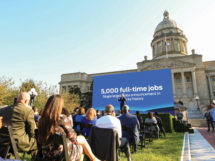
For the first time in U.S. history, the majority of jobless workers over age 25 have at least some college education.
Of 9 million Americans looking for work in April, 4.7 million had gone to college, while 4.3 million had not, according to an analysis of Labor Department data by Investors Business Daily.
Couple the unemployment rate among those with higher education and the fact that only 33 percent of available jobs in the next six years will require a four-year degree, and you have a big problem, according to economist Ted Abernathy Jr., executive director of the Southern Growth Policies Board.
Universities need to assess the role of higher education in a rapidly changing world, Abernathy told educators and community leaders gathered last month at Eastern Kentucky University for the International Town and Gown Conference. Abernathy was the keynote speaker of the weeklong event, which drew more than 200 people from throughout the United States and several countries.
American workers today need skills more than they need a “college experience,” he said. Too many graduates are finding that not only are they crippled by student loan debt, the job market isn’t ready for them.
“Some ‘college’ is no guarantee to anything; you have to have skill,” Abernathy said. “I don’t know if you need a degree or not, but you need some skills.”
The percentage of students “we tell to go to college” more than doubles the percentage of available jobs requiring college degrees, he said.
“Is the job of the universities to provide training for work, or is it to provide educational enlightenment? If you say both, I am fine with that as long as you do both,” Abernathy challenged. “But you can’t say both and do one.
“If you say enlightenment, that’s OK, too. But I will tell you that most of the governors I talk with say, ‘That’s fine, but the state shouldn’t be funding it.’”
Not supplying market demands
The unemployment rate among those with some college or more demonstrates that what America is producing is not what is needed in the economic world, he said.
“Whose job is it to figure that out? Is it the student’s job to understand that? Maybe,” Abernathy said. “Maybe the student gets to choose. And if they do, we’re not doing a very good job of teaching them where the jobs are going to be.”
For example, there is only one job for every three graduating social scientists in America today, but four jobs for every graduate in science, technology, engineering and math (known collectively as the STEM disciplines). Universities may find it cheaper to teach social science instead of STEM skills, he said.
It is clear that modern workforce members typically need more skills than those attained in high school, according to Abernathy, but the big question is what those marketable skills are and, “How in the world are we going to get them to people?”
Universities need to consider that America is on the verge of a complete shift in the way people learn. Hands-on, self-taught learning is becoming more prevalent, he said.
Big-name universities experimenting with free, online video-lecture learning – similar to that used by The Kahn Academy – predict that in 50 years there could only be 10 institutions of higher learning.
That idea may seem far-fetched, Abernathy said, but changes as drastic have happened in less time. For example, newspaper ad revenue was $64 billion in 2000. In 2011, it fell to the levels of 60 years ago. Major metropolitan cities such as New Orleans, Birmingham and Mobile will no longer have daily newspapers beginning September.
And just five years ago, the very biggest names in the financial world included Bear Stearns, Lehman Brothers, Washington Mutual (or WaMu) and Wachovia. None of those exists today.

‘Accelerated continuous change’
While it is impossible to predict the future, watching the trends can help universities – as well as businesses and communities – prepare for it, Abernathy said.
“You’re going to have to expect continuous change: accelerated continuous change,” he said. “And if you can deal with all of that … then there are some ways to move your place forward.”
Before colleges and universities can do that, they have to know where they are now, Abernathy said. Then they have to decide where they want to be.
“Every day, you should be adding to what you already know. You should be continuously changing it, and it ought to be in a global context,” he said.
To thrive in an ever-changing world, organizations of all types must have strong leadership and connected citizens, be quick to act and have realistic goals. They also must get better at training their workforces, Abernathy said, and learn how to collaborate effectively.
“You can’t sit back and wait. You have to be intentional in what you’re doing,” he said. “You have to do things because you choose to do them, not because they just happen to you along the way.”
It also is important to know what customers expect and not underestimate the competition.
One of the most common questions asked of Southern Growth Policies Board, Abernathy said, is, “What is the new normal?”
There has never been a normal, he said; those people really want to know what is going to happen in the future.
“Everyone wants to know where we’re going,” he said. “We don’t know because we haven’t decided yet. The future is not a place that you go, it is a place that you make.”
Lorie Hailey is associate editor of The Lane Report. She can be reached at lorie@lanereport.com.





Add Comment